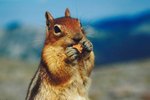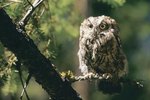
The Adirondack region of upstate New York occupies 6 million acres of preserved land that includes forests, lakes, rivers and ponds. The Adirondacks are home to more than 220 species of birds, 35 species of amphibians and reptiles and more than 50 species of mammals. After the sun goes down, tourists may turn in after a day of recreation, but the party animals of the Adirondack’s nocturnal wildlife scene are out and about to roam the night.
Look Up In the Sky
Many birds of prey hunt at night, soaring the starry skies and prowling from the treetops. Owls are abundant in the Adirondack region, including the great horned owl, barred owl, eastern screech owl and the northern saw-whet owl, all seeking mice and other small mammals. Not all nocturnal creatures in flight are birds, however, as a number of bats awaken from their daytime slumber to patrol the nighttime skies. Bats who call the Adirondack region home include the little brown bat, the silver-haired bat, the red bat and the eastern small-footed bat.
Marvelous Night for Moonlit Prowls
Evening prowls in the Adirondacks are joined by a number of predators on quests for food, including the bobcat, who hunts small and medium-sized mammals and birds. Eastern coyotes, gray and red foxes and black bears attain their diets through a combination of hunting and scavenging during the twilight and first hours after dusk. While many people know the raccoon as a masked bandit of rural neighborhood trashcans, the wilderness brings out the hunter as he seeks out small mammals, ducks, frogs and fish to supplement the foraged berries and pilfered foods from unsecured campsites.
Nighttime Noshing
Although not a hunter, the porcupine also prefers to dine at night. He spends hours devouring his way through an herbivore’s menu of trees that include white pines, beech, red spruce, yellow birch and sugar maple, as well as acorns, fruits and nuts. The opossum is another nighttime nibbler, but his omnivorous diet yields the most diverse bounty. Opossums are not fussy, feasting on small mammals, insects, amphibians, fruits, nuts, seeds, slugs, earthworms, abandoned carnage, birds and their eggs.
Mother Nature’s Evening Serenade
Several types of frogs reside in the Adirondack region, including the leopard frog, tree frog, bullfrog and wood frog. From their high-pitched croaks and the howl of a coyote to the trill of an Eastern screech owl and the hoot of a great horned owl, nighttime becomes anything but peaceful in the Adirondacks. The nocturnal natives perform a symphony of hunting, gnawing and vocalizing sounds that keep campers awake and guessing as they nervously ponder the region's creatures of the night.
References
- Fodor’s Travel: The Adirondacks and Thousand Islands: Places to Explore
- Department of Environmental Conservation: New York State: Great Horned Owl
- The Cornell Lab of Ornithology: All About Birds: Northern Saw-whet Owl
- ESF Adirondack Ecological Center: Adirondack Mammals
- ESF: Adirondack Ecological Center: Adirondack Mammals: Raccoon
- ESF: Adirondack Ecological Center: Porcupine
- ESF: Adirondack Ecological Center: Opossum
- ESF: Adirondack Ecological Center: Adirondack Amphibians and Reptiles
Photo Credits
-
Ablestock.com/AbleStock.com/Getty Images




